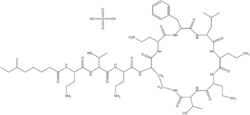Difference between revisions of "Polypeptide Antibiotics"
| Line 1: | Line 1: | ||
| − | {{ | + | {{unfinished}} |
{{toplink | {{toplink | ||
|linkpage =WikiDrugs | |linkpage =WikiDrugs | ||
| Line 15: | Line 15: | ||
==Mechanism of Action== | ==Mechanism of Action== | ||
| + | Look in text book.....Endotoxins etc.... | ||
==Spectrum of Activity== | ==Spectrum of Activity== | ||
| + | Due to nature of their mechanism of action they won't work on gram positive species as they are unable to penetrate the cell wall. | ||
| + | * Highly active against gram negatives, including ''Pseudomonas'' species. | ||
| + | * Action is potentiated by cationic detergents (Chlorohexidine) and by chelating agents (EDTA). | ||
| + | * Have a synergistic action with other antibiotics that are able to penetrate the cell wall of gram negatives. | ||
| + | * Their actio is inhibited by the presence of cell debris (pus) and divalent cations. | ||
==Pharmacokinetic Considerations== | ==Pharmacokinetic Considerations== | ||
| + | They are strong bases, positively charged at physiological pH and are large molecules. As such they are slowly absorbed by the gastro-intestinal tract and cross into transcellular fluids very poorly. Therefore to provide systemic therapy it must be given parenterally. They bind to cell membranes and tend to accumulate with long term dosing. It is excreted by the urine, totally unchanged, just by glomerular filtration and so have a tendency to accumulate in renal disease. | ||
==Side Effects and Contraindications== | ==Side Effects and Contraindications== | ||
| + | |||
| + | * Colistin is less toxic than Polymyxin B. | ||
| + | * Systemic use can lead to nephrotoxicity, especially in dogs. | ||
| + | * '''Must not use in renal failure patients''' - as will accumulate in the kidney. | ||
| + | * If sulphate salts are used in the drug preperation, pain and necrosis can occur at the injection site. | ||
Revision as of 15:36, 23 October 2008
| This article is still under construction. |
|
|
This type of antibiotic are basic cyclic decapeptides. The commonly used drugs are Polymyxin B and E (Colistin).
Mechanism of Action
Look in text book.....Endotoxins etc....
Spectrum of Activity
Due to nature of their mechanism of action they won't work on gram positive species as they are unable to penetrate the cell wall.
- Highly active against gram negatives, including Pseudomonas species.
- Action is potentiated by cationic detergents (Chlorohexidine) and by chelating agents (EDTA).
- Have a synergistic action with other antibiotics that are able to penetrate the cell wall of gram negatives.
- Their actio is inhibited by the presence of cell debris (pus) and divalent cations.
Pharmacokinetic Considerations
They are strong bases, positively charged at physiological pH and are large molecules. As such they are slowly absorbed by the gastro-intestinal tract and cross into transcellular fluids very poorly. Therefore to provide systemic therapy it must be given parenterally. They bind to cell membranes and tend to accumulate with long term dosing. It is excreted by the urine, totally unchanged, just by glomerular filtration and so have a tendency to accumulate in renal disease.
Side Effects and Contraindications
- Colistin is less toxic than Polymyxin B.
- Systemic use can lead to nephrotoxicity, especially in dogs.
- Must not use in renal failure patients - as will accumulate in the kidney.
- If sulphate salts are used in the drug preperation, pain and necrosis can occur at the injection site.
